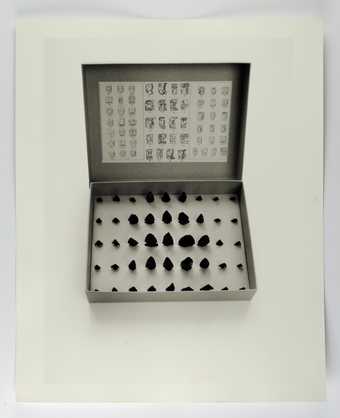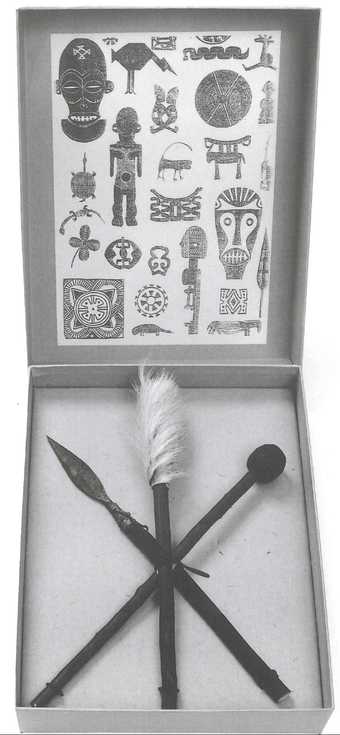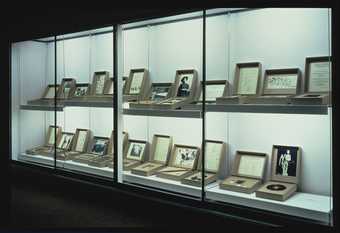Susan Hiller has noted that the phrase ‘Sites of Disturbance’ would make an apt title for From the Freud Museum 1991–6 (Tate T07438) as a whole, since like the installation it captures the incongruity and incoherence of experience and memory which are customarily concealed behind ‘the routine “I” of daily life’.1 The institution of the museum and its collections, including but not limited to the Freud Museum (the site of the first installation of the work as At the Freud Museum in 1994), are also among the sites disturbed, including the more fundamental intellectual aspiration to keeping the order and to exerting control over the world of objects and ideas by naming and categorising them. As this essay will show, the archaeological boxes in From the Freud Museum contain words and things but refrain from spelling out the connections between them. Such connections are suggested but remain fundamentally indeterminate and unstable – an intrinsic part of the work which invites each viewer to piece its elements together.

Fig.1
Susan Hiller
From the Freud Museum 1991–6, box 006 Chamin-ha’/House of Knives (collected, 1992)
Tate T07438
© Susan Hiller
Even in the boxes with the most stereotypically ethnographic contents, such as 006 Chamin-ha’/House of Knives (collected, 1992) (fig.1) and 023 Provenance/source (located, 1994), the relationship between the three-dimensional objects and the flat, (photo-)copied and therefore already mediated text and images on display belies expectation. In 006 Chamin-ha’/House of Knives excerpts from a classic Mayan calendar are juxtaposed with modern obsidian blades. Neither sheds any light on the other as their link is not merely obscure but subjective, founded in a personal memory of a myth. As Hiller elaborated in her artist’s book After the Freud Museum:
The House of Knives is one of the most horrible parts of the underworld in the Popul-Vuh, the sacred text of the Quiche Maya. One thing I remember from reading it when I was in Guatemala is the description of the terrible grinding sound made by thousands of obsidian knives when they clash against each other. Pre-Columbian Mayan obsidian blades were exquisitely and elegantly formed. The ones in this box are made for tourists; they’re extremely sharp.2
The box label reveals that the calendar is ancient while the blades are contemporary, thereby trumping the viewer’s first likely expectation that the two belong to the same context. Yet whatever disappointment or irritation is elicited by their assumed lack of authenticity, this is subsequently challenged by the assertion that the blades can still do what they are meant to – they are still ‘extremely sharp’. Similarly, 023 Provenance/source (located, 1994) (fig.2) brings together a bundle of miniature weapons with photocopied sketches of ancient tribal art objects and patterns from across Africa. The same kind of expectations are provoked to be quashed anew: as Hiller has commented, ‘This miniature weapon bundle is so well made that possibly it should be viewed as an index to a complex tradition of skills and knowledge rather than as a meaningless souvenir for tourists.’3 Adaptability and survival are as admirable as military prowess and as genuine as archaeological artefacts. And, more importantly, through provoking and then trumping expectations, each box, its words and things, delineates the ideological positionalities of the viewer; we are all boxed in by the specificity and limitations of our perspectives.

Fig.2
Susan Hiller
From the Freud Museum, box 023 Provenance/source (located, 1994)
© Susan Hiller
‘Words and things’ is also the verbatim translation of Les mots et les choses, historian of ideas and philosopher Michel Foucault’s 1966 comparative study of knowledge systems and the implicit or explicit principles of their systematisation. In the English translation of Foucault’s study, the literal approach was dropped in favour of The Order of Things, to avoid confusion with two books previously published under the title Words and Things.4 In part at least, The Order of Things offers an archaeology of the taxonomical drive and the processes by which it became the defining feature of the human sciences, a drive which From the Freud Museum references, mimics, and upon which it critically reflects. Going further to examine the historical and intellectual processes through which the human sciences established themselves as autonomous and necessary fields of knowledge, Foucault makes note of the similarities between ethnology and psychoanalysis – the two disciplines that have the greatest impact on Hiller’s practice:
Ethnology, like psychoanalysis, questions not man himself, as he appears in the human sciences, but the region that makes possible knowledge about man in general; like psychoanalysis, it spans the whole field of that knowledge in a movement that tends to reach its boundaries … The privilege of ethnology and psychoanalysis, the reason for their profound kinship and symmetry, must not be sought, therefore, in some common concern to pierce the profound enigma, the most secret part of human nature; in fact, what illuminates the space of their discourse is much more the historical a priori of all the sciences of man – those great caesuras, furrows, and dividing-lines which traced man’s outline in the Western episteme and made him a possible area of knowledge. It was quite inevitable, then, that they should both be sciences of the unconscious: not because they reach down to what is below consciousness in man, but because they are directed towards that which, outside man, makes it possible to know, with a positive knowledge, that which is given to or eludes his consciousness.5
Since the publication of The Order of Things, both ethnology, namely cultural anthropology, and psychoanalytic methods as they apply to therapy and the analysis of cultural phenomena have changed profoundly. This can be largely attributed to a growing awareness of the interface between knowledge and power and the political and scholarly critique of ‘the human sciences’ exercised by feminist, LGBT+, (post-)Marxist and post-/decolonial movements. Yet Foucault’s observations concern the fundamental structure that supports and legitimises psychoanalysis and cultural anthropology as fields of knowledge: the focus of both of these disciplines is on these very supports. This condition, which is materially exploited in From the Freud Museum as well as the rest of Hiller’s practice, marks them both out as sites of potential disturbance. As Foucault observes:
In relation to the ‘human sciences’, psychoanalysis and ethnology are rather ‘counter-sciences’; which does not mean that they are less ‘rational’ or ‘objective’ than the others, but that they flow in the opposite direction, that they lead them back to their epistemological basis, that ceaselessly ‘unmake’ that very man who is creating and re-creating his positivity in the human sciences.6
When it comes to anthropology, Hiller’s history with it is evoked more often than it is understood, nor is its ambivalence adequately appreciated. Her academic training as a PhD candidate at Tulane University, New Orleans, with a National Science Foundation fellowship in anthropology, conducting fieldwork in Mexico, Guatemala and Belize, is brought up by art critics, perhaps to convey intellectual credibility, or to explain her work’s scholarly references. The allusion to and mimicry of scientific methodologies and curatorial display are widespread in contemporary art practice, and in Hiller’s case anthropology is only one of the disciplines evoked, along with archaeology, psychoanalysis, art history and visual sociology. In the foreword to her 1991 edited book The Myth of Primitivism Hiller describes the primal scene of her abandonment of anthropology and advent into visual art, which is worth quoting at length:
A long time ago, when I was doing postgraduate work in anthropology, I was so moved by the images I saw during a slide lecture on African art that I decided to become an artist. My previously inchoate thoughts and feelings about anthropology as a practice and about art as a practice seemed to fall into place in one complex moment of admiration, empathy, longing, and self-awareness. I promised myself to happily abandon the writing of a doctoral thesis whose objectification of the contrariness of lived events was destined to become another complicit thread woven into the fabric of ‘evidence’ that would help anthropology become a ‘science’. In contrast, I felt art was, above all, irrational, mysterious, numinous: the images of African sculpture I was looking at stood as a sign for all this, a sign whose meaning, strangely, was already in place awaiting my long-overdue recognition. I decided I would become not an anthropologist but an artist: I would relinquish factuality for fantasy. The final pleasure for me that afternoon in the African art lecture was making a quick drawing of each slide image as it flashed on the screen … And the pleasures of drawing bypassed words, which was wonderful, too. Words ‘about’ the peoples represented by the marvellous sculpture seemed redundant; the more facts, analyses, and theories I had learned, the further away I felt from any real connection with them, and what I wanted was connection, empathy, identification. And yet … What I was not then able to see is that repudiating an objectifying discourse (anthropology) in favour of a subjectifying discourse (art) does not even begin to resolve the extraordinary lived contradictions of merely being a subject in a culture that … does not allow ‘a synthesis between ideology and poetry’.7
Even in this description of the artist’s primal scene there is no hint of triumphalism but the acknowledgement of a commencing (or perhaps continuing) battle towards overcoming the division of ‘objectifying’ and ‘subjectifying’ discourses, ‘science’ and art.8 In Archive Fever, a profoundly Freudian reflection on the vicissitudes of memory and its archiving, philosopher Jacques Derrida repeatedly stumbles against Freud’s doublespeak, which does not stem from dishonesty but a fundamental condition of psychoanalysis that Foucault, Hiller and many others have observed before and after him: ‘all the Freudian theses are cleft, divided, contradictory, as are the concepts, beginning with that of the archive.’9 As such, while on the one hand Freud puts forth the idea of a ‘psychic archive’ with its own encoded structure that cannot be reduced to memory, on the other he reverts time and again to ‘the theatre of archaeological digs’ in which origins are accessible, materialised and speak for themselves, circumventing ‘the laborious deciphering of the archive’.10 Both a science and a counter-science which wears its double identity more proudly on its sleeve than cultural anthropology, psychoanalysis is inflected by the contradictions that Hiller points out, but usually stops short of acknowledging them.

Fig.3
Susan Hiller
At the Freud Museum 1994
Installation view
Freud Museum, London
© Susan Hiller
With the original manifestation of the work, At the Freud Museum 1994 (fig.3), Hiller’s intervention in the Freud Museum as a site and an idea took material form; it claimed space and drew attention to its ‘landlord’, Freud’s own personal collection of small sculptures. Art historian and curator Jon Wood describes Freud’s personal collection as a materialisation of things less tangible; to Freud, he suggests, the collection represented
concrete, three-dimensional ‘evidence’ and ‘proof’ of the workings of the ancient human mind. The pieces … offered embodied and embedded myths, demonstration models and symbols; ancient vestiges that had survived into the present, and which offered touchstones to the past.11
The boxes of From the Freud Museum do not re-order nor do they add to this collection, but rather seek to change its meaning. It is specifically the assumed evidentiary value of objects, their status as ideas materialised, that comes under attack. This is not to suggest that Hiller’s collections are inspired by object-oriented philosophy’s intention to restore to objects a material autonomy that frees them from cultural framings and human interpretation. What is restored to the archived objects, however, is their polysemy, their resistance to a single (or at least a single privileged) interpretation; Hiller’s pieces, which are fragments and not items, also ‘embody’ and ‘embed’ myths and symbols, just as Freud’s collections do, but such myths and symbols remain volatile, uncertain and dissentingly diverse. The fragmentary nature of the boxed words and things spills over to the structure and order of their collection in the installation. In this respect From the Freud Museum is guided by an ‘anarchival impulse’, to evoke art historian and critic Hal Foster’s oft-cited observation:
concerned less with absolute origins than with obscure traces (perhaps ‘anarchival impulse’ is the more appropriate phrase), these artists are often drawn to unfulfilled beginnings or incomplete projects – in art and in history alike – that might offer points of departure again.12
The Greek prefix ‘an(a)-’ means above but also against, upside down and wrong or cancelled out. The ‘anarchive’, as a result, becomes a vehicle of artistic interest tinged with ambivalence and even scepticism; it simultaneously threatens destruction, intimates subversion and promises regeneration of the archive.13 Artists working with/in archives and on/against the idea of the archive undertake, in curator Okwui Enwezor’s words, ‘critical transactions predicated on opening up new pictorial and historiographic experiences against the exactitude of the photographic trace’14 – or, in the case of From the Freud Museum, against the misleading evidentiary transparency of archaeological discovery and museological documentation.
If From the Freud Museum boldly mimics the archive and delves into the margins of psychoanalysis to announce, by example, a separate form of knowledge specific to art, it does not do so only in the negative, by outlining the limitations of more systematic and systematised disciplines. Artistic knowledge is materialised in From the Freud Museum, captured in its boxes and in between them. The specificity of that knowledge is difficult to describe, as it exists not as concrete realisation but as intersubjective potentiality. Reflecting on the relationship between anthropology and art, Hiller admits to not being able to articulate an abstract definition of the latter, while asserting her conviction in its possibilities:
I still don’t know what art is, as a category of actions and things distinct from all other categories, although I think I can recognise art-like or artistic behaviour when I see it, and I have some idea of what it is artists do … Artists’ work does not allow discontinuities between experience and reality, and it eliminates any gap between the investigator and the object or situation investigated.15
